- Meaning of Gladiolus Flowers
- Significance of Gladiolus as a Symbol
- Courage and Strength
- Nobility and Elegance
- Remembrance and Mourning
- Success and Achievement
- Loyalty and Devotion
- Conclusion
- Historical Importance of Gladiolus
- Characteristics of Gladiolus Plants
- 1. Height and Structure
- 2. Flowers
- 3. Bulbs
- 4. Sun and Soil Requirements
- 5. Hardy Zones
- 6. Additional Notes
- Growth and Appearance
- Cultivation and Care of Gladiolus
- Choosing the Right Location
- Preparing the Soil
- Planting the Bulbs
- Watering and Fertilizing
- Staking and Supporting
- Protecting from Pests and Diseases
- Harvesting and Storing
- Gladiolus: Symbolism in Art and Culture
- 1. Strength and Courage
- 2. Nobility and Elegance
- 3. Remembrance and Tribute
- 4. Birth Month Flower
- 5. Creativity and Inspiration
- Gladiolus in Paintings and Sculptures
- 1. Vincent Van Gogh’s “Gladioli”
- 2. Auguste Rodin’s “Spring”
- 3. Georgia O’Keeffe’s “Red Gladiola”
- 4. Caravaggio’s “The Martyrdom of Saint Cecilia”
- Cultural Symbolism in Gladiolus
- Questions and Answers:
- What is the meaning behind the gladiolus flower?
- Why is the gladiolus flower associated with courage?
- What makes the gladiolus flower a symbol of nobility?
- What are some popular colors of gladiolus flowers?
- When is the gladiolus flower typically in bloom?
- How do you care for gladiolus flowers?
- Videos: What Will Your Future Partner/Spouse Be Like and How Will it Begin? ✨ ❤️ ✨ | Pick a card
The gladiolus flower has long been known as a symbol of courage and nobility. Its name, derived from the Latin word “gladius,” meaning sword, reflects its association with the fearless fighters of ancient Rome, the gladiators. Just as these brave warriors displayed strength and determination in the arena, so too does the gladiolus bloom with vibrant colors and intricate petals.
With its tall, slender stem and multiple blooms, the gladiolus stands tall and proud, much like the warriors it represents. Its vertical growth symbolizes a sense of resilience and determination in the face of adversity. This flower reminds us to stay strong and unyielding in difficult times, just as the gladiators did in the arena.
Additionally, the gladiolus is often associated with nobility and sophistication. Its striking beauty and elegant form make it a popular choice for formal occasions and floral arrangements. From regal purple to delicate pink, the gladiolus comes in a variety of colors, each with its own symbolic meaning.
Whether displayed in a bouquet or growing in a garden, the gladiolus serves as a reminder of the enduring qualities of courage and nobility. Its vibrant blooms and graceful stature inspire us to embrace our inner gladiator, facing challenges head-on with strength and dignity.
Meaning of Gladiolus Flowers
The gladiolus flower carries various meanings and symbolism. Here are some of the common meanings associated with gladiolus:
- Strength and Courage: The gladiolus is often seen as a symbol of strength and courage. Its tall, sturdy stem and vibrant colors represent qualities like resilience and bravery.
- Nobility: The gladiolus is also associated with nobility and elegance. Its name is derived from the Latin word “gladius,” which means sword. This ties the flower to gladiators, who were known for their bravery and honor.
- Remembrance: Gladiolus flowers are often used to express remembrance. They can be seen as a way to honor and remember loved ones who have passed away.
- Infatuation: In the language of flowers, the gladiolus can also represent infatuation and love at first sight. It can be a fitting gift for someone you feel an immediate attraction or admiration towards.
Overall, the gladiolus is a versatile flower with rich symbolism. It can be given on various occasions to convey different emotions and messages.
Significance of Gladiolus as a Symbol
Gladiolus, with its vibrant colors and striking appearance, has gained significance as a symbol in various cultures around the world. This beautiful flower represents several qualities and holds different meanings depending on the context and the culture it is associated with.
Courage and Strength
One of the primary meanings associated with gladiolus is courage and strength. Due to its tall and upright growth, the flower is often seen as a symbol of resilience and determination. Just like a gladiator who fights with bravery and determination, gladiolus stands tall and strong even in adverse conditions.
Nobility and Elegance
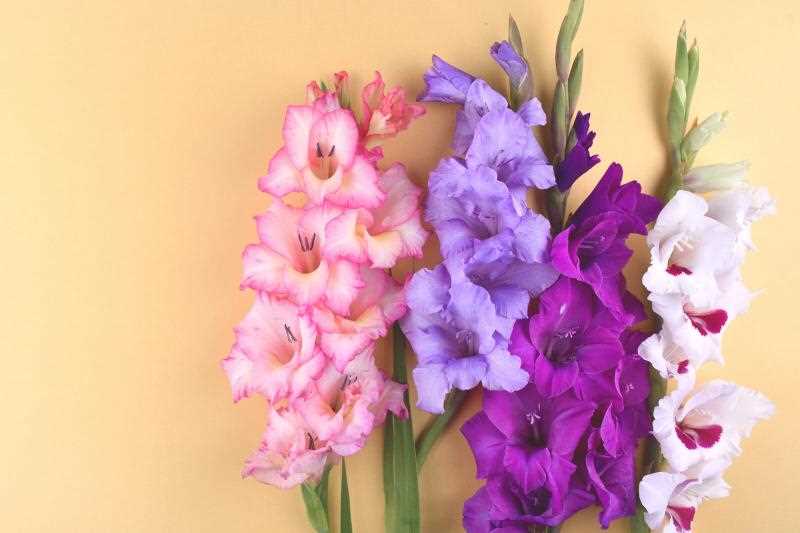
In addition to representing courage, gladiolus is also considered a symbol of nobility and elegance. Its long stem, graceful form, and exquisite blossoms make it a popular choice for formal and sophisticated arrangements. In ancient times, this flower was associated with the affluent and noble classes.
Remembrance and Mourning
In some cultures, gladiolus is also used as a symbol to express remembrance and mourning. The flower’s association with funerals and memorials is said to stem from its Latin name, which means “sword.” This connection with the sword represents the transition from life to death and the memories left behind.
Success and Achievement
Gladiolus is often seen as a symbol of success and achievement. Its tall and upright growth is seen as a metaphor for reaching for the sky and achieving goals. This makes it a popular choice for congratulatory gifts and floral arrangements to celebrate milestones and accomplishments.
Loyalty and Devotion
In some cultures, gladiolus is also associated with loyalty and devotion. Its name is derived from the Latin word “gladius,” which means sword. This connection with the sword symbolizes the dedication and loyalty of a person who is willing to fight for their loved ones and protect what is important to them.
Conclusion
Overall, gladiolus holds great significance as a symbol due to its association with courage, nobility, remembrance, success, and loyalty. Whether used in art, literature, or as a gift, gladiolus uplifts spirits and conveys powerful messages of strength and beauty.
Historical Importance of Gladiolus
The gladiolus flower has a rich history and holds a significant cultural and symbolic importance in various civilizations throughout the ages. Here are some key points highlighting the historical importance of gladiolus:
- Ancient Roman Gladiatorial Combats: The gladiolus flower gained popularity during ancient Roman times due to its association with gladiatorial combats. Gladiators were admired for their courage, strength, and noble virtues and were often adorned with gladiolus flowers before entering the arena.
- Symbol of Nobility and Victorious Spirit: Gladiolus, with its tall stems and vibrant blooms, became a symbol of nobility and strength. It represented the victorious spirit of warriors and was used in decorations during triumphal processions and victory celebrations.
- Religious and Mythological Significance: Gladiolus was also significant in ancient Greek and Roman mythology. It was associated with the goddess Flora, the deity of flowers and spring. Gladiolus was believed to be a gift from the gods and was used in religious ceremonies and rituals.
- Medieval Herbology and Medicine: During the Middle Ages, gladiolus gained recognition for its medicinal properties. It was believed to have healing powers and was used in remedies for various ailments, including digestive disorders and respiratory problems.
- Modern Symbol of Remembrance: In modern times, gladiolus has taken on new symbolism and significance. It is often used as a flower of remembrance and is commonly seen in funeral arrangements and memorial services, paying homage to the bravery and courage of those who have passed.
Overall, the historical importance of gladiolus showcases the enduring fascination and admiration that people have had for this beautiful flower throughout the centuries. Its association with courage, nobility, victory, and remembrance has solidified its place in history and continues to inspire and captivate people to this day.
Characteristics of Gladiolus Plants
Gladiolus plants are known for their tall and elegant flower spikes that are adorned with brightly colored blooms. These plants belong to the family Iridaceae and are native to South Africa. Here are some of the key characteristics of gladiolus plants:
1. Height and Structure
Gladiolus plants typically grow to a height of 2 to 5 feet (60 to 150 cm). They have a tall, erect and sword-shaped foliage that is often green in color. The main attraction of the gladiolus plant is its flower spike, which stands tall above the foliage.
2. Flowers
The flowers of gladiolus plants are large and showy, making them a popular choice for cut flower arrangements. The blooms can come in a wide range of colors including red, pink, yellow, white, and purple. Each flower spike can bear multiple blooms, with each bloom lasting for about a week.
3. Bulbs
Gladiolus plants grow from bulbs, which are underground storage organs. The bulbs of gladiolus are corms, which are vertical, flattened structures that store nutrients for the plant. These corms are usually planted in spring and bloom in summer or early fall.
4. Sun and Soil Requirements
Gladiolus plants thrive in full sun conditions. They prefer well-drained soil that is rich in organic matter. It is important to provide adequate water to the plants, especially during the growing and blooming period.
5. Hardy Zones
Gladiolus plants are typically grown as annuals or tropical perennials. They are hardy in USDA hardiness zones 8 to 10, which means they can tolerate mild winters. In colder climates, gladiolus bulbs need to be dug up and stored indoors during the winter months.
6. Additional Notes
Gladiolus plants are easy to grow and can be a great addition to any garden. They are known for their resilience and adaptability, making them suitable for a wide range of climates and soils. Gladiolus plants are also a favorite among hummingbirds and butterflies.
Growth and Appearance
The Gladiolus is a tall and majestic flower that can grow up to 3 to 4 feet in height. It has long, slender leaves that emerge from the base of the plant. The leaves are green in color and have a sword-like shape, giving the flower its name, which is derived from the Latin word for sword.
Atop the tall stem, the Gladiolus produces beautiful and vibrant flowers. The flowers can range in color from white and yellow to pink, red, purple, and even blue. Some varieties also have multi-colored blooms. The flowers are large and showy, with six petals that form a funnel-shaped blossom with a characteristic central spike.
The central spike of the Gladiolus is composed of numerous individual flowers, called florets, which are arranged in a double row. Each floret opens gradually from the bottom to the top, extending the flowering period of the plant. This unique flowering pattern creates a striking visual effect and makes the Gladiolus an excellent choice for flower arrangements and bouquets.
The Gladiolus is also known for its fragrance. Some varieties have a mild, sweet scent, while others have a more pronounced fragrance. The scent of the Gladiolus is often described as floral and somewhat spicy.
Overall, the Gladiolus is a beautiful and impressive flower that adds elegance and charm to any garden or floral display.
Cultivation and Care of Gladiolus
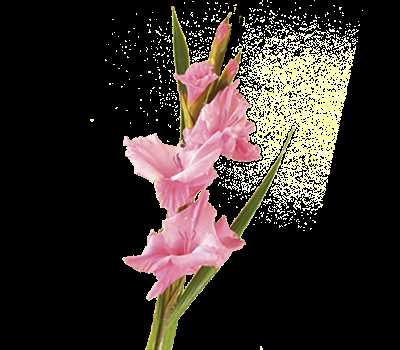
Cultivating gladiolus is a rewarding and fairly straightforward process. By following a few simple steps, you can enjoy the beauty of gladiolus blooms in your garden or home.
Choosing the Right Location
Gladiolus plants thrive in full sunlight, so it is important to choose a location that receives at least six to eight hours of direct sunlight per day. They also prefer well-drained soil, so make sure the planting area has good drainage.
Preparing the Soil
Before planting gladiolus, it is essential to prepare the soil properly. Start by removing any weeds or grass from the planting area. Loosen the soil to a depth of 8-10 inches and mix in organic matter, such as compost, to improve the soil’s fertility and drainage.
Planting the Bulbs
Gladiolus bulbs, also known as corms, should be planted in the spring after the danger of frost has passed. Dig a hole that is about 4-6 inches deep and space the bulbs 6-8 inches apart. Place the bulb in the hole with the pointed end facing up and cover it with soil.
Watering and Fertilizing
Gladiolus plants require regular watering, especially during dry periods. Water the plants deeply, ensuring that the water reaches the root zone. Avoid overwatering, as it can lead to rotting of the bulbs.
Apply a balanced fertilizer, such as a 10-10-10 formula, to the soil before planting and again when the plants begin to grow. This will provide essential nutrients for healthy growth and abundant blooming.
Staking and Supporting
As gladiolus plants grow tall and produce heavy flower spikes, staking and supporting the stems is necessary to prevent them from bending or falling over. Install stakes or use a trellis system near the plants and gently tie the stems to the support as they grow.
Protecting from Pests and Diseases
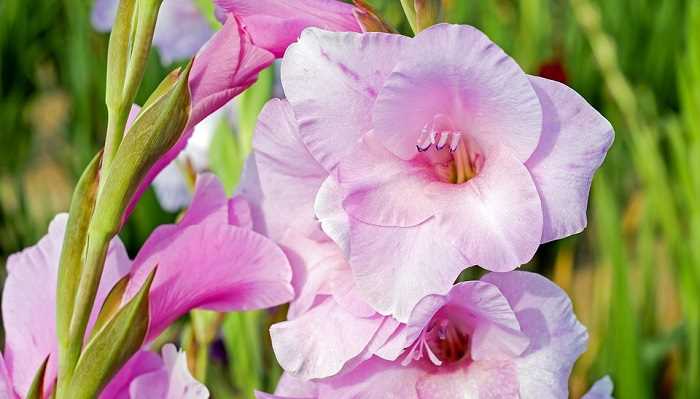
Gladiolus plants can be susceptible to pests, such as aphids and thrips, and diseases like botrytis and fusarium wilt. Regularly inspect the plants for any signs of infestation or disease and take appropriate measures to control them, such as using insecticides or fungicides if necessary.
Harvesting and Storing
Gladiolus blooms can be cut for floral arrangements as soon as the first few flowers open. Cut the stem at an angle and place it in a vase with fresh water. To store gladiolus bulbs for the winter, carefully dig them up after the foliage dies back. Allow them to dry for a few days and then store them in a cool and dry location until the next planting season.
By following these cultivation and care practices, you can enjoy the stunning beauty of gladiolus flowers year after year!
Gladiolus: Symbolism in Art and Culture
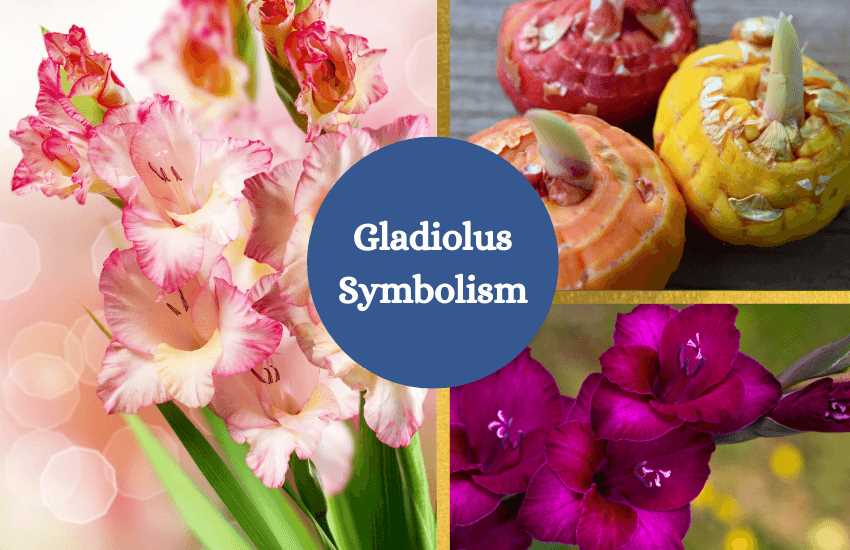
The gladiolus flower has been a symbol of various meanings and symbolism in art and culture throughout history. Here are a few examples:
1. Strength and Courage
The gladiolus flower is often associated with strength and courage due to its tall and strong stem. In ancient Rome, gladiators carried gladiolus flowers into the arena as a sign of their bravery and fearlessness. The flower’s name even comes from the Latin word “gladius,” which means sword, further emphasizing its connection to strength and valor.
2. Nobility and Elegance
The gladiolus flower is also associated with nobility and elegance. Its tall stem and graceful blooms give it a regal appearance, making it a popular choice for formal floral arrangements and bouquets. In artwork, the gladiolus is often depicted alongside kings, queens, and other members of the nobility to symbolize their status and elegance.
3. Remembrance and Tribute
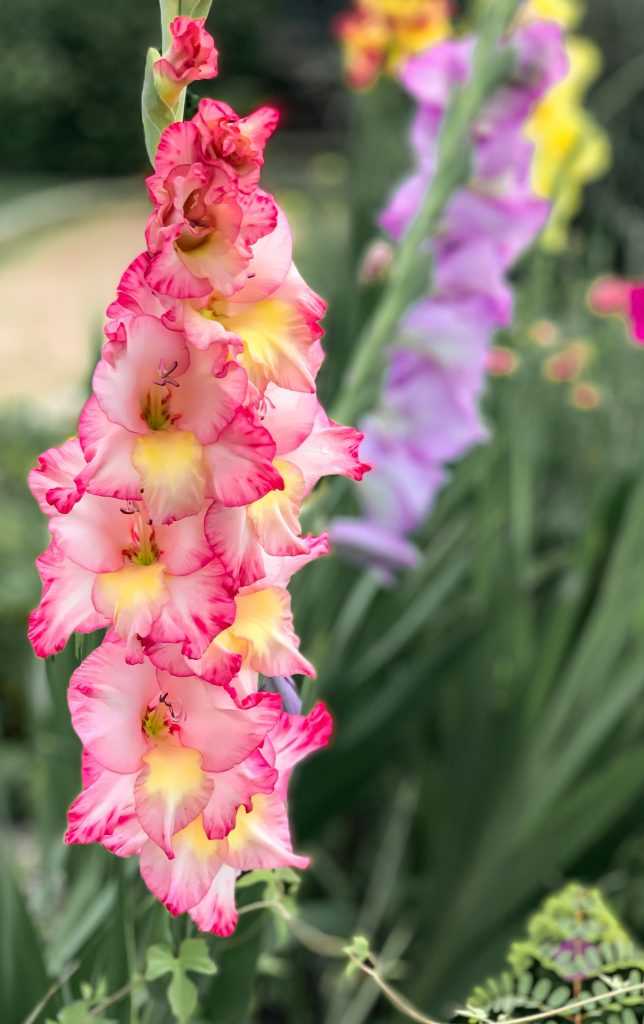
In some cultures, the gladiolus flower is used to pay tribute to loved ones who have passed away. Its long-lasting blooms and vibrant colors make it a fitting choice for funeral arrangements and memorials. The gladiolus is seen as a symbol of remembrance and is often included in floral tributes to honor the memory of the deceased.
4. Birth Month Flower
The gladiolus is the birth month flower for August and symbolizes sincerity and infatuation. In astrology and horoscopes, it is believed that those born in August are passionate and ambitious, traits that are reflected in the gladiolus flower’s symbolism. People born in August often receive gladiolus flowers as a gift to celebrate their birth month.
5. Creativity and Inspiration
The gladiolus flower is considered to be a symbol of creativity and inspiration. Its vibrant colors and unique shape have inspired artists and poets throughout history. The flower’s name is also associated with the Latin word “gladius,” which means sword, suggesting that it can be a symbol of artistic expression and the power of words.
| Symbolism | Meaning |
|---|---|
| Strength and Courage | Tall and strong stem, associated with gladiators |
| Nobility and Elegance | Tall stem and regal appearance |
| Remembrance and Tribute | Used in funeral arrangements and memorials |
| Birth Month Flower | Sincerity and infatuation, associated with August |
| Creativity and Inspiration | Inspired artists and poets throughout history |
These are just a few examples of the symbolism that the gladiolus flower holds in art and culture. Its enduring beauty and rich history continue to make it a beloved and meaningful choice in various contexts.
Gladiolus in Paintings and Sculptures
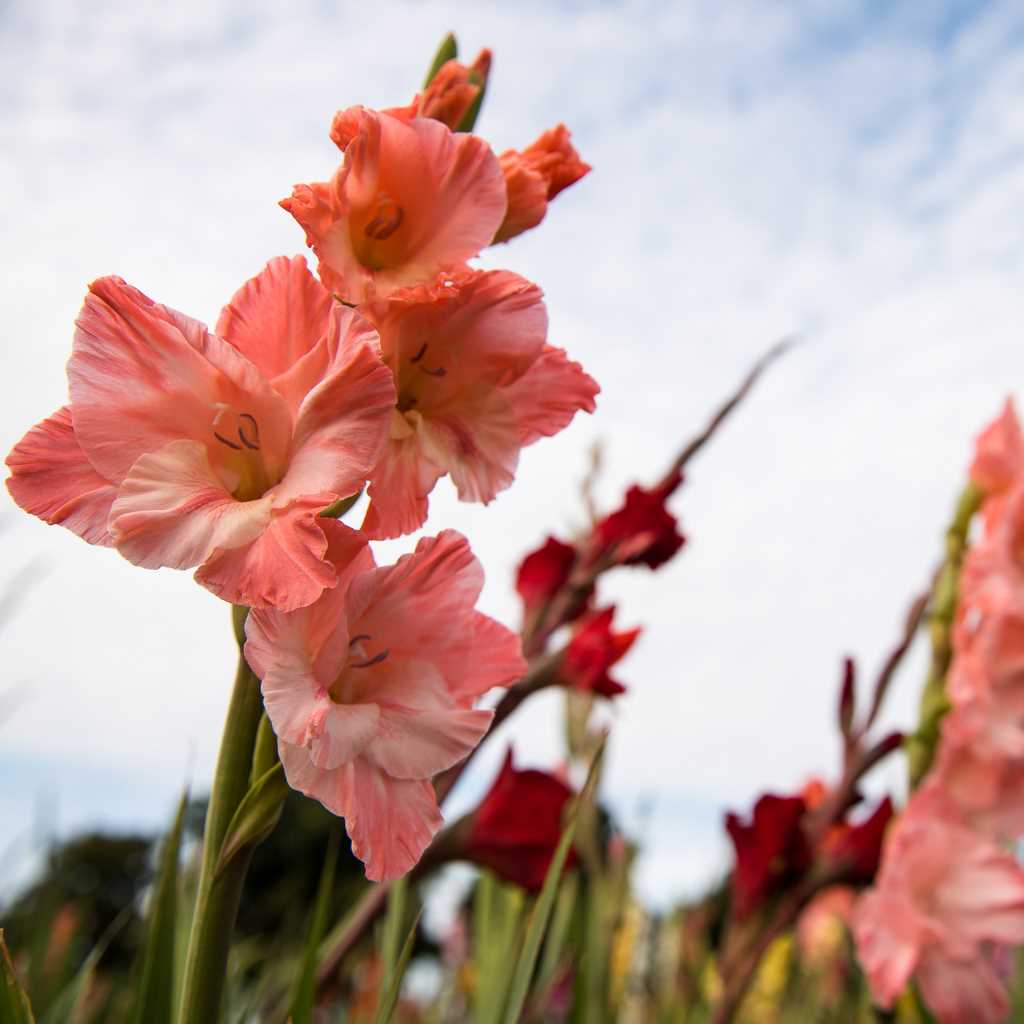
The gladiolus flower has long been a popular subject in paintings and sculptures due to its striking beauty and symbolic meaning. Artists throughout history have depicted the gladiolus in various ways, capturing its vibrant colors and elegant form. Here are some notable examples:
1. Vincent Van Gogh’s “Gladioli”
In 1886, renowned Dutch painter Vincent Van Gogh created a series of still-life paintings featuring gladioli. One of the most famous works from this series is simply titled “Gladioli.” In this painting, Van Gogh used bold brushstrokes and vibrant colors to highlight the gladioli’s dramatic presence. The artwork showcases the flower’s unique shape and vivid hues, demonstrating Van Gogh’s mastery of color and composition.
2. Auguste Rodin’s “Spring”
“Spring” is a bronze sculpture created by French sculptor Auguste Rodin in 1884. This masterpiece features a female figure holding a gladiolus flower in her hands. The gladiolus symbolizes courage and nobility in Rodin’s sculpture, reflecting the theme of rejuvenation and rebirth associated with spring. The delicate details of the gladiolus and its placement in the sculpture’s composition add depth and meaning to the artwork.
3. Georgia O’Keeffe’s “Red Gladiola”
American artist Georgia O’Keeffe is known for her large-scale flower paintings, and the gladiolus makes an appearance in several of her works. One notable painting is “Red Gladiola” created in 1929. O’Keeffe’s representation of the gladiolus focuses on its vibrant red color and intricate details. By isolating the flower on a simple background, she draws attention to its beauty and invites viewers to appreciate its graceful form.
4. Caravaggio’s “The Martyrdom of Saint Cecilia”
In Caravaggio’s painting “The Martyrdom of Saint Cecilia,” gladiolus flowers are depicted in a symbolic manner. The painting portrays Saint Cecilia, the patron saint of music, surrounded by a group of anguished figures. In the foreground, Caravaggio includes a basket of gladiolus flowers as a representation of the saint’s martyrdom. The gladiolus in this context serves as a reminder of Cecilia’s courage and inner strength.
These examples demonstrate the gladiolus’s significance as a subject in art. Whether used to symbolize courage, elegance, or rebirth, the gladiolus has inspired artists in their portrayal of natural beauty and profound meaning.
Cultural Symbolism in Gladiolus

The gladiolus flower has held various cultural and symbolic meanings throughout history. In many civilizations, it has been associated with bravery, strength, and nobility. The name “gladiolus” is derived from the Latin word “gladius,” which means “sword.” This association with the sword has contributed to the flower’s symbolism as a representation of courage and valor.
In ancient Roman times, gladiolus flowers were often seen as a symbol of the gladiators who fought in arenas. Just as the gladiators displayed bravery and courage in their battles, the gladiolus was seen as a representation of these qualities. The flower was also associated with Mars, the Roman god of war, further solidifying its connection to bravery and strength.
Additionally, the gladiolus has been linked to nobility and elegance. The tall, elegant stalks of the flower were often used in floral arrangements for special occasions and ceremonies. Its vibrant colors and graceful appearance made it a popular choice for adding a touch of sophistication and beauty to any event.
Furthermore, the gladiolus has symbolized faithfulness and loyalty. Its long-lasting blooms and resilience have been seen as a representation of unwavering dedication and commitment. In this context, the gladiolus has been used in expressing devotion and loyalty in romantic relationships and friendships.
Overall, the gladiolus holds cultural symbolism that encompasses bravery, strength, nobility, elegance, faithfulness, and loyalty. Its meanings and significance have evolved over time but continue to resonate in various cultures and settings.
Questions and Answers:
What is the meaning behind the gladiolus flower?
The gladiolus flower symbolizes courage and nobility.
Why is the gladiolus flower associated with courage?
The gladiolus flower is associated with courage because of its tall, strong stem and vibrant colors, which represent bravery and strength.
What makes the gladiolus flower a symbol of nobility?
The gladiolus flower is considered a symbol of nobility because of its elegant appearance and association with the gladiators of ancient Rome, who were admired for their bravery and honor.
What are some popular colors of gladiolus flowers?
Some popular colors of gladiolus flowers include red, pink, purple, yellow, and white.
When is the gladiolus flower typically in bloom?
The gladiolus flower is typically in bloom during the summer months, from June to September.
How do you care for gladiolus flowers?
To care for gladiolus flowers, make sure to plant them in well-drained soil, provide them with plenty of sunlight, and water them regularly. They also benefit from regular fertilization and the removal of faded blooms.







